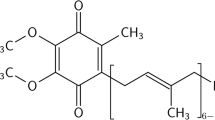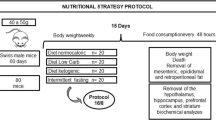Abstract
Conditions in which glucose metabolism is impaired due to insulin resistance are associated with memory impairment. It was hypothesized that supplemental chromium (Cr) may alleviate insulin resistance in type 2 diabetes and consequently improve memory acquisition, depending upon its source and level. In a complete randomized design experiment, male Wistar rats (n = 60; weighing 200–220 g) were fed either normal (8%, normal diet (ND)) or high-fat (40%, high-fat diet (HFD)) diet and supplemented with Cr as either chromium-glycinate (CrGly) or chromium-acetate (CrAc) at doses of 0, 40, or 80 μg/kg body weight (BW) via drinking water from 8 to 20 weeks of age. Feeding HFD induced type 2 diabetes, as reflected by greater glucose/insulin ratio (2.98 vs. 2.74) comparing to feeding ND. Moreover, HFD rats had greater BW (314 vs. 279 g) and less serum (53 vs. 68 μg/L) and brain (14 vs. 24 ng/g) Cr concentrations than ND rats. High-fat diet caused a 32% reduction in expressions of glucose transporters 1 and 3 (GLUTs) in brain tissue and a 27% reduction in mean percentage time spent in the target quadrant and a 38% increase in spatial memory acquisition phase (SMAP) compared with ND. Compared with supplemental Cr as CrAc, CrGly was more effective to ameliorate response variables (i.e., restoration of tissue Cr concentration, enhancement of cerebral GLUTs expressions, and reduction of the glucose/insulin ratio and SMAP) in a dose–response manner, especially in rats fed HFD. Supplemental Cr as CrGly may have therapeutic potential to enhance insulin action and alleviate memory acquisition in a dose-dependent manner, through restoring tissue Cr reserve and enhancing cerebral GLUTs expressions.





Similar content being viewed by others
References
Lau FC, Bagchi M, Sen CK et al (2008) Nutrigenomic basis of beneficial effects of chromium(III) on obesity and diabetes. Mol Cell Biochem 317:1–10
Stranahan AM, Norman ED, Lee K et al (2008) Diet induced insulin resistance impairs hippocampal synaptic plasticity and cognition in middle-aged rats. Hippocampus 18:1085–1088
Nilsson LG, Nilsson E (2009) Overweight and cognition. Scan J Psychol 50:660–507
Morris BW, MacNeil S, Hardisty CA et al (1999) Chromium homeostasis in patients with type II (NIDDM) diabetes. J Trace Elem Med Biol 13:57–61
Anderson RA (2003) Chromium and insulin resistance. Nutr Res Rev 16:267–275
Vincent JB (2000) The biochemistry of chromium. J Nutr 130:715–718
Cefalu WT, Wang ZQ, Zhang XH et al (2002) Oral chromium picolinate improves carbohydrate and lipid metabolism and enhances skeletal muscle glut-4 translocation in obese, hyperinsulinemic (JCR-LA corpulent) rats. J Nutr 132:1107–1114
Chen WY, Chen CJ, Liu CH et al (2009) Chromium supplementation enhances insulin signalling in skeletal muscle of obese KK/HlJ diabetic mice. Diabetes Obes Metab 11:293–303
Wang ZQ, Zhang XH, Russell JC et al (2006) Chromium picolinate enhances skeletal muscle cellular insulin signaling in vivo in obese insulin-resistant JCR: LA-cp rats. J Nutr 136:415–420
McLeod MN, Gaynes BN, Golden RN (1999) Chromium potentiation of antidepressant pharmacotherapy for dysthymic disorder in 5 patients. J Clin Psychiatry 60:237–240
McLeod MN, Golden RN (2000) Chromium treatment of depression. Int J Neuropsychopharmacol 3:311–314
Shinde UA, Sharma G, Xu YJ et al (2004) Insulin sensitising action of chromium picolinate in various experimental models of diabetes mellitus. J Trace Elem Med Biol 18:23–32
Clodfelder BJ, Chang C, Vincent JB (2004) Absorption of the biomimetic chromium cation triaqua-mu(3)-oxo-mu-hexapropionatotrichromium(III) in rats. Biol Trace Elem Res 98:159–69
Preuss HG, Echard B, Perricone NV et al (2008) Comparing metabolic effects of six different commercial trivalent chromium compounds. J Inorg Biochem 102:1986–1990
Mackowiak P, Krejpcio Z, Sassek M et al (2010) Evaluation of insulin binding and signaling activity of newly synthesized chromium(III) complexes in vitro. Mol Med Rep 3:347–353
Wieczorek D, Szymusiak H, Wieloch A et al (2005) Selected methods of identification and purity assessment of biomimetic chromium(III) complex with propionic acid. J Hum Nutr Metabol 32:880–885
Wieczorek D, Wieloch A, Krejpcio Z (2007) Synthesis and selected physicochemical properties of novel chromium(III) complexes with acetic and n-valeric acids. Curr Trends Commodity Sci II:1059–66
Krejpcio Z, Szymusiak H, Wójciak RW et al (2005) Biologically active chromium(III) compounds and their significance in human nutrition and pharmacotherapy. J Hum Nutr Metabol 32:495–498
Winocur G, Greenwood CE, Piroli GG et al (2005) Memory impairment in obese Zucker rats: an investigation of cognitive function in an animal model of insulin resistance and obesity. Behav Neurosci 119:1389–1395
AOAC (1990) Official methods of analysis, 15th edn. Association of Official Analytical Chemists, Washington, DC
Morris RG, Garrud P, Rawlins JN et al (1982) Place navigation impaired in rats with hippocampal lesions. Nature 297:681–683
Baydas G, Yasar A, Tuzcu M (2005) Comparison of the impact of melatonin on chronic ethanol induced learning and memory impairment between young and aged rats. J Pineal Res 39:346–352
Kamal A, Biessels GJ, Duis SE et al (2000) Learning and hippocampal synaptic plasticity in streptozotocin-diabetic rats: interaction of diabetes and ageing. Diabetologia 43:500–506
Dogukan A, Sahin N, Tuzcu M et al (2009) The effects of chromium histidinate on mineral status of serum and tissue in fat-fed and streptozotocin-treated type II diabetic rats. Biol Trace Elem Res 131:124–132
SAS (2002) User’s Guide. Statistics Version 9th. Statistical Analysis System. SAS Inst. Inc, Cary, NC
Littell CR, Milliken GA, Stroup WW et al (1996) SAS® System for Mixed Models. SAS Inst. Inc., Cary, NC
Anderson RA (1998) Chromium glucose intolerance and diabetes. J Am Coll Nutr 17:548–555
Vincent JB (2004) Recent advances in the nutritional biochemistry of trivalent chromium. Proc Nutr Soc 63:41–47
Vincent JB (2003) Recent advances in the biochemistry of chromium(III). J Trace Elem Exp Med 16:227–236
Kazi TG, Afridi HI, Kazi N et al (2008) Copper chromium manganese iron nickel and zinc levels in biological samples of diabetes mellitus patients. Biol Trace Elem Res 122:1–18
Reed MJ, Meszaros K, Entes LJ et al (2000) A new rat model of type 2 diabetes: the fat-fed streptozotocin-treated rat. Metabolism 49:1390–1394
Sahin K, Onderci M, Tuzcu M et al (2007) Effect of chromium on carbohydrate and lipid metabolism in a rat model of type 2 diabetes mellitus: the fat-fed streptozotocin-treated rat. Metab Clin Exp 56:1233–1240
Broadhurst CL, Domenico P (2006) Clinical studies on chromium picolinate supplementation in diabetes mellitus: a review. Diabetes Technol Ther 8:677–887
Striffler JS, Law JS, Polansky MM et al (1995) Chromium improves insulin-response to glucose in rats. Meta Clin Exp 44:1314–1320
Machalinski B, Walczak M, Syrenicz A et al (2006) Hypoglycemic potency of novel trivalent chromium in. J Trace Elem Med Biol 20:33–39
Sun YJ, Clodfelder BJ, Shute AA et al (2002) The biomimetic [Cr3O(O2CCH2CH3)6(H2O)3]+ decreases plasma insulin, cholesterol, and triglycerides in healthy and type II diabetic rats but not type I diabetic rats. J Biol Inorg Chem 7:852–862
Ghosh D, Bhattacharya B, Mukherjee B et al (2002) Role of chromium supplementation in Indians with type 2 diabetes mellitus. J Nutr Biochem 13:690–697
Clodfelder BJ, Gullick BM, Lukaski HC et al (2005) Oral administration of the biomimetic [Cr3O(O2CCH2CH3)6(H2O)3]+ increases insulin sensitivity and improves blood plasma variables in healthy and type 2 diabetic rats. J Biol Inorg Chem 10:119–130
Anderson RA (2000) Chromium in the prevention and control of diabetes. Diabetes Metab 26:22–27
Vincent JB, Bennett R (2007) Potential and purported roles for chromium in insulin signaling: the search for the holy grail. In: Vincent JB (ed) The nutritional biochemistry of chromium(III). Elsevier, Amsterdam, pp 139–60
Mantych G, James DE, Chung HD et al (1992) Cellular localization and characterization of Glut 3 glucose transporter isoform in human brain. Endocrinology 131:1270–1278
Nagamatsu S, Kornhauser JM, Burant CF et al (1992) Glucose transporter expression in brain. J Biol Chem 267:467–472
Devaskar S, Zahm DS, Holtzclaw L et al (1991) Developmental regulation of the distribution of rat brain insulin-insensitive (Glut 1) glucose transporter. Endocrinology 12:1530–1540
Simpson IA, Dwyer D, Malide D et al (2008) The facilitative glucose transporter GLUT3: 20 years of distinction. Am J Physiol Endocrinol Metab 295:242–253
Furler SM, Jenkins AB, Storlein LH et al (1991) In vivo location of the rate-limiting step of hexose uptake in muscle and brain tissue of rats. Am J Physiol 26:337–447
McCarty MF (1994) Enhancing central and peripheral insulin activity as a strategy for the treatment of endogenous-depression—an adjuvant role for chromium picolinate. Med Hypotheses 43:247–452
Ryan CM, Freed MI, Rood JA et al (2006) Improving metabolic control leads to better working memory in adults with type 2 diabetes. Diab Care 29:345–351
Stewart R, Liolitsa D (1999) Type 2 diabetes mellitus cognitive impairment and dementia. Diabet Med 16:93–112
Pavlović DM, Pavlović AM (2008) Dementia and diabetes mellitus. Srp Arh Celok Lek 136:170–175
Whitmer RA (2007) Type 2 diabetes and risk of cognitive impairment and dementia. Curr Neurol Neurosci Rep 7:373–380
Zarros A, Liapi C, Galanopoulou P et al (2009) Effects of adult-onset streptozotocin-induced diabetes on the rat brain antioxidant status and the activities of acetylcholinesterase (Na(+)K (+))- and Mg(2+)-ATPase: modulation by l-cysteine. Metab Brain Dis 24:337–348
Reagan LP (2007) Insulin signaling effects on memory and mood. Curr Opin Pharmacol 7:633–637
De la Monte SM, Tong M, Lawton M et al (2009) Nitrosamine exposure exacerbates high fat diet-mediated type 2 diabetes mellitus non-alcoholic steatohepatitis and neurodegeneration with cognitive impairment. Mol Neurodegeneration 24:4–54
Barrou Z, Lemaire A, Boddaert J et al (2008) Diabetes mellitus and cognition: is there a link? Psychol Neuropsychiatr Vieil 6:189–198
Bruehl H, Wolf OT, Sweat V et al (2009) Modifiers of cognitive function and brain structure in middle-aged and elderly individuals with type 2 diabetes mellitus. Brain Res 1280:186–194
Beauquis J, Homo-Delarche F, Giroix MH et al (2010) Hippocampal neurovascular and hypothalamic-pituitary-adrenal axis alterations in spontaneously type 2 diabetic GK rats. Exp Neurol 222:125–134
Refaie FM, Esmat AY, Mohamed AF et al (2009) Effect of chromium supplementation on the diabetes induced-oxidative stress in liver and brain of adult rats. Biometals 22:1075–1087
Hallschmid M, Schultes B (2009) Central nervous insulin resistance: a promising target in the treatment of metabolic and cognitive disorders? Diabetologia 52:2264–2269
Attenburrow MJ, Odontiadis J, Murray BJ et al (2002) Chromium treatment decreases the sensitivity of 5-HT2A receptors. Psychopharmacology 159:432–436
Davidson JR, Abraham K, Connor KM et al (2003) Effectiveness of chromium in atypical depression: a placebo-controlled trial. Biol Psychiatry 53:261–264
Docherty JP, Sack DA, Roffman M et al (2005) A double-blind placebo controlled exploratory trial of chromium picolinate in atypical depression: effect on carbohydrate craving. J Psychiatr Pract 11:302–314
Moreira T, Malec E, Ostenson CG et al (2007) Diabetic type II Goto Kakizaki rats show progressively decreasing exploratory activity and learning impairments in fixed and progressive ratios of a lever-press task. Behav Brain Res 180:28–41
Khanam R, Pillai KK (2006) Effect of chromium picolinate on modified forced swimming test in diabetic rats: involvement of serotonergic pathways and potassium channels. Basic Clin Pharmacol Toxicol 98:155–159
Franklin M, Odontiadis J (2003) Effects of treatment with chromium picolinate on peripheral amino acid availability and brain monoamine function in the rat. Pharmacopsychiatry 36:176–180
Khanam R, Pillai KK (2007) Effect of chronic chromium picolinate in animal models of anxiety and memory. Fundam Clin Pharmacol 21:531–534
Piotrowska A, Młyniec K, Siwek A et al (2008) Antidepressant-like effect of chromium chloride in the mouse forced swim test: involvement of glutamatergic and serotonergic receptors. Pharmacol Rep 60:991–995
Bailey MM, Boohaker JG, Jernigan PL et al (2008) Effects of pre- and postnatal exposure to chromium picolinate or picolinic acid on neurological development in CD-1 mice. Biol Trace Elem Res 124:70–82
Acknowledgments
We thank the Veterinary Control and Research Institute of Elazig for providing the experimental facility and Firat University for supporting this experiment. The authors have no conflicting financial interests.
Author information
Authors and Affiliations
Corresponding author
Rights and permissions
About this article
Cite this article
Sahin, K., Tuzcu, M., Orhan, C. et al. The Effects of Chromium Complex and Level on Glucose Metabolism and Memory Acquisition in Rats Fed High-Fat Diet. Biol Trace Elem Res 143, 1018–1030 (2011). https://doi.org/10.1007/s12011-010-8905-9
Received:
Accepted:
Published:
Issue Date:
DOI: https://doi.org/10.1007/s12011-010-8905-9




